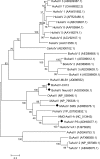Neurotropic astrovirus in cattle with nonsuppurative encephalitis in Europe
- PMID: 24989603
- PMCID: PMC4313157
- DOI: 10.1128/JCM.01195-14
Neurotropic astrovirus in cattle with nonsuppurative encephalitis in Europe
Abstract
Encephalitis is a frequently diagnosed condition in cattle with neurological diseases. Many affected animals present with a nonsuppurative inflammatory reaction pattern in the brain. While this pattern supports a viral etiology, the causative pathogen remains unknown in a large proportion of cases. Using viral metagenomics, we identified an astrovirus (bovine astrovirus [BoAstV]-CH13) in the brain of a cow with nonsuppurative encephalitis. Additionally, BoAstV RNA was detected with reverse transcription-PCR and in situ hybridization in about one fourth (5/22 animals) of cattle with nonsuppurative encephalitis of unknown etiology. Viral RNA was found primarily in neurons and at the site of pathology. These findings support the notion that BoAstV infection is a common cause of encephalitis in cattle. Phylogenetically, BoAstV-CH13 was closely related to rare astrovirus isolates from encephalitis cases in animals and a human patient. Future research needs to be directed toward the pathogenic mechanisms, epidemiology, and potential cross-species transmission of these neurotropic astroviruses.
Copyright © 2014, American Society for Microbiology. All Rights Reserved.
Figures



References
-
- World Organization for Animal Health. 2004. Manual of diagnostic tests and vaccines for terrestrial animals, 5th ed. World Organization for Animal Health, Paris, France.
-
- Heim D, Fatzer R, Hornlimann B, Vandevelde M. 1997. Frequency of neurologic diseases in cattle. Schweiz. Arch. Tierheilkd. 139:354–362 (In German.) - PubMed
-
- Fatzer R, Steck F. 1974. Histological differential diagnosis in cattle suspected of rabies. Schweiz. Arch. Tierheilkd. 116:347–356 (In German.) - PubMed
-
- Vandevelde M, Higgins RJ, Oevermann A. 2012. Veterinary neuropathology, p 57 John Wiley & Sons, Chichester, United Kingdom.
-
- Fankhauser R. 1961. Sporadic meningo-encephalomyelitis in cattle. Schweiz. Arch. Tierheilkd. 103:225–235 (In German.)
Publication types
MeSH terms
Substances
Associated data
- Actions
LinkOut - more resources
Full Text Sources
Other Literature Sources

